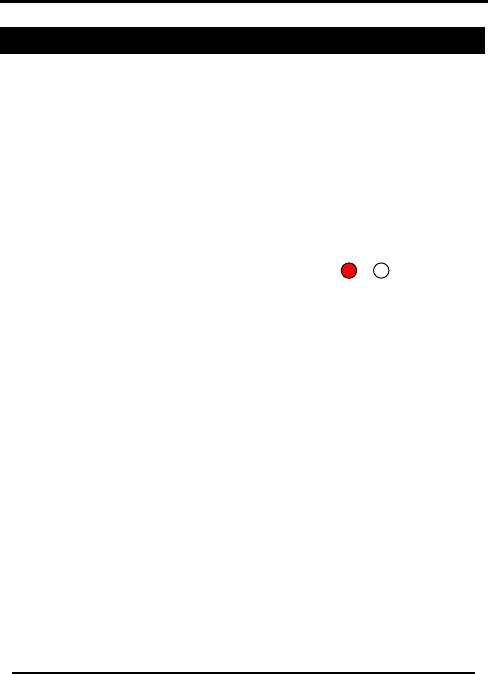User's Manual
Table Of Contents
- 1. General Information
- 2. Technical Specifications
- 3. Installation
- 4. Wiring Instructions
- 5. Reader Functionality
- 5.1 Transmit Mode
- 5.2 Programming the AYC- F/G/M60 Series
- Programming Menu
- Entering Programming Mode
- Exiting Programming Mode
- Selecting Keypad Transmission Format
- Keypad Transmission Format Option Number
- Option 1: Single Key, 6-Bit Wiegand (Rosslare Format)
- Option 2: Single Key, 6-Bit Wiegand Nibble and Parities
- Option 3: Single Key, 8-Bit Wiegand Nibbles Complemented
- Option 4: 4 Keys Binary + Facility Code, 26-Bit Wiegand
- Option 5: 1 to 5 Keys + Facility Code, 26-Bit Wiegand
- Option 6: 6 Keys BCD and parity bits, 26-Bit Wiegand
- Option 7: Single Key, 3x4 Matrix Keypad (MD-P64)
- Option 8: 1 to 8 Keys BCD, Clock & Data
- Option 9: Single Key, 4-bit Wiegand
- Selecting Proximity Card Transmission Format
- Changing the Programming Code
- Changing the Facility Code
- Setting the Backlight and Reader Format
- Return to Factory Default Settings
- Replacing a Lost Programming Code
- 6. Controller Functionality
- 6.1 Normal, Secure, and Master Users
- 6.2 Modes of Operation
- 6.3 Auxiliary Input & Output
- 6.4 Door Alarms
- 6.5 Internal Case and Back Tamper
- 6.6 Lockout Feature (Keypad / Card Tamper)
- 6.7 Request to Exit (REX) Function
- 6.8 Secure Application Appurtenances
- 6.9 Programming the AYC- F/G/M60
- Programming Menu
- Entering Programming Mode
- Exiting Programming Mode
- Changing Lock Strike Code
- Changing Auxiliary Code
- Changing the Programming Code
- Changing the Normal / Secure Code
- Changing the Normal / Bypass Code and Door Chime Settings
- Setting Fail Safe/Secure Operation, Tamper Siren and Lock Strike Release Time
- Defining the Auxiliary Input and Output
- Quick Reference Guide for Auxiliary Mode Setting
- Detailed Reference Guide
- Setting the Lockout Feature
- Setting the backlight behavior
- Enrolling Primary and Secondary Codes
- Deleting Primary and Secondary Codes
- Relay Codes Assignment
- Relay Code Assignment using Search Method
- Pin Code Length / Factory Default Settings
- Replacing a Lost Programming Code
- Replacing a Lost Normal / Secure Code

AYC-Qx4 family manual Page 14
Mode/Transmit
Door/Program
Red
5. Reader Functionality
The AYC- F/G/M60 series can function both as a reader and as a
controller. If the unit is connected to standard access controller, it
functions as a reader, indicated by one beep immediately after
power-on reset.
The following explains how the AYC- F/G/M60 series functions as a
reader.
5.1 Transmit Mode
When the AYC- F/G/M60 is in Transmit Mode, it is ready to receive
data from a presented Proximity Card or an entered PIN code.
When the reader is in Transmit
Mode, the Transmit LED is red and
the Program LED is off.
When a Proximity Card or Keyboard entry is being transmitted, the
Transmit LED will flash green.
Keyboard data can be sent via one of eight different Keypad
Transmission Formats. For more information, see Selecting Keypad
Transmission Format on page 16.
Proximity Cards presented to the reader are always sent in either
26-Bit Wiegand, Clock & Data or, Wiegand Card + PIN format. See
Selecting Proximity Card Transmission Format on page 22 for more
information.
5.2 Programming the AYC- F/G/M60 Series
Programming the AYC- F/G/M60 series is done solely via the unit's
keypad driven Programming Menu System. To reach the
Programming Menu System the AYC- F/G/M60 must first be
placed into Programming Mode. During the F/G/M60 's
manufacturing process certain codes and settings are pre-
programmed. These settings are the called the "Default Factory
Settings".
The table below shows the names of all the AYC- F/G/M60 Menus.










